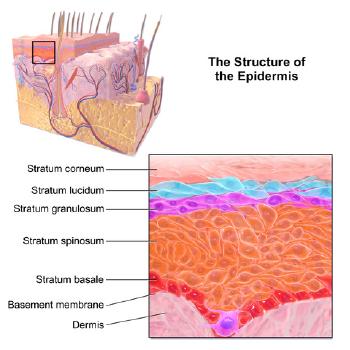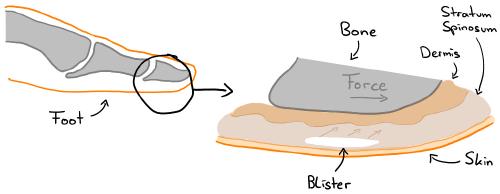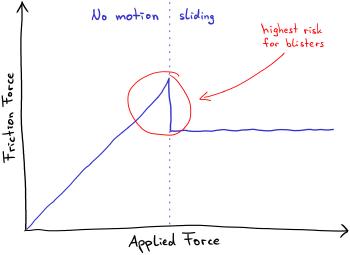Blisters: Scientific insights and how to prevent blisters
For this article, I went through a lot of scientific papers and looked at what the state of the science is on the topic of blisters. So this article is a kind of summary of the scientific findings, which is why there are a few things to note:
- All sources used are cited and given below.
- The papers were not taken randomly from anywhere, but are valid and frequently cited works of respected scientists.
- The mentioned papers themselves reference other papers that I have not included here. So there are many more possible sources and scientific results for every aspect of this article.
Content
Summary
- Shear forces cause blisters (favored but not caused by pressure, friction, heat or moisture).
- There are many risk factors, some of which you can influence (e.g. amount of luggage or smoking).
- Prevent blisters: E.g. by frequently used shoes and good socks.
- Intact blisters can be lanced and deflated.
Biology lesson: How are blisters formed?
Blisters are generally cavities between layers of skin that have filled with fluid [2]. However, this article is only about friction blisters, so not, for example, burn blisters.
The skin is made up of different layers, but blisters only form in the stratum spinosum layer.

What causes blisters?
So, now you know. But let’s get into the details.
What are shear forces?
Place your hand on the table. Skin is soft and flexible, so you can wiggle your hand back and forth a bit without completely moving it. Of course, this pulls a little on the skin, which are these shear forces.
Push your hand enough so that it actually starts to slide, and you’ll notice how you need less force as long as it slides. So the highest risk you have for blisters is not the actual friction (even though they are calles friction blisters), but at the point just before friction occurs.

The risk of getting blisters increases the stronger the shear forces are, but only until you start to slip. So if you slip in your shoe, it’s bad, but not the worst situation.
What increases shear forces?
Mainly moisture. If you sweat or otherwise get your foot wet, the maximum achievable shear force increases before your foot slips (red marked area shifts further to the upper right).

Other factors include choice of footwear. And that brings us directly to the first strategies to avoid blisters: Often used, dry, broken-in and comfortable shoes. Any pressure point means higher shear forces or friction, both of which are bad. If you have no discomfort at all, you have minimal stress on the skin.
Myths about blister formation
“Blisters are caused by friction/heat/moisture/hot spots/pressure/…. caused.”
Not really.
Shear forces are responsible (see above), but these are present with friction and are amplified by the other effects.
Especially moisture (often caused by heat) and pressure are favoring factors.
Risk factors
There are some things you can do to prevent blisters, but there are also some risk factors that cannot be influenced.
Risk factors that cannot be influenced
People with dark skin color have a significantly reduced risk of blisters. In a study of 339 participants [3], participants completed a 21-km walk and were then examined. Participants with darker skin had the fewest blisters, while people of Asian background had the most. This is because darker skin seems to be less malleable, resulting in less deformation and a lower risk of blisters. Many other studies came to the same conclusion regarding skin color [4][5].
Age, although statistically rather unreliable, is also a risk factor, but with a higher risk for younger people [4]. On the one hand, this could be due to more elastic skin, but often younger study participants are also less experienced.
The gender also showed to be a risk factor in some studies [3][6][8]. More specifically, women showed slightly increased incidence of blisters. Possible reasons are an increased number of steps, softer skin, but also inappropriate backpack designs for women.
Personal factors
I’ve talked a lot above about forces in the skin, these of course increase with the total weight bearing down on the skin.
The equipment weight can often influenced easily. Besides the total weight (e.g. 33 kg in the 21 km study mentioned above), the type of weight distribution also plays a role. For example, if the weight is evenly distributed to the front and back, it reduces shear forces and the risk of blisters[7].
Every additional kilogram of weight increases the energy consumption of about 4 % [8]. One kilogram on the feet (e.g. due to heavy boots) even by up to 10%!
However, body weight is also a risk factor [4], although not all studies have found a correlation [5]. The risk goes both ways, by the way: People with high BMI, but especially people with low BMI are at increased risk for blisters.
General proneness to blisters is also an interesting factor [5][10]. In other words, if you got blisters a lot in the past, you will in the future. Of course, this says nothing about the reasons, maybe just wrong socks were the reason in the past. On the other hand, if you never get blisters and you don’t change anything, then you probably won’t get blisters in the future. New shoes or different socks should then be chosen wisely.
Another factor are past diseases (in the last 12 months) that were in the leg area [3][5][10]. Unfortunately, it was not recorded which diseases were involved, so it is not possible to say why exactly this leads to more blisters.
Also smoking leads to a higher risk of blisters [3][4] – besides the other known side effects. However, alcohol did not show a statistically significant effect.
Clothing
The footwear is also a notable factor [5][6]. Especially the frequency with which one wears the hiking shoes has an influence on the frequency of blisters: The more often and longer you wear the shoes, the less often you get blisters. Shoe and foot adapt to each other in a certain way.
Especially socks have a big influence, especially cotton has negative influence. What a good sock system looks like is described below.
Other factors
The length of the tour is of course a risk factor [8]. Every day there is a chance of developing a blister, so the overall probability of getting a blister at some point during the tour naturally increases with duration. However, if you have no problems with blisters in general, this probability remains low.
As mentioned above, moisture increases the shear forces acting on the skin. Therefore, you should make sure to have dry feet.
Avoid blisters
Minimize risk factors
Should be clear: The risk factors described above should be minimized if you have any influence on them. The best way to do this is often very individual and I only give general advice here.
Shoes
Good and especially fitting & broken-in shoes are important factors to avoid blisters [2][4][5][10]. Wearing shoes regularly in particular is an important aspect, as the shoe and the foot adapt to each other (it is not just the shoe that is broken in). Through frequent wear, especially the skin adapts to the stress, is strengthened and blisters are less likely to form.
Finding a good sock system
Finding a suitable sock system is promising. There are a few to choose from, as studies have shown.
Synthetic fiber socks
Even though synthetic fibers aren’t really popular in the outdoors: acrylic and polypropylene fibers (but also polyester and nylon) are good at preventing blisters [2][8][9]. Cotton should be avoided!
The theory with synthetic fibers: they are hydrophobic, so they repel moisture, which is transferred from the foot to the outside with the temperature gradient (called wicking). Thus, the foot remains dry, provided that the moisture does not collect in the shoe, but can go somewhere.
Hydrophobic synthetic fibers proved to be very successful in many studies.
Plush-knit socks
Thick, fluffy socks can somewhat absorb the forces applied to the skin (the shear forces then put stress on the sock fibers instead of the skin) and preventing blisters [1][2][9]. However, some studies used fluffy (plush-knit) socks as a sock over another sock (see “two-sock strategy” below). So whether the effect is solely due to the thicker sock alone is questionable.
Two-sock strategy
Many studies that have examined sock systems have often analyzed wearing two socks on top of each other [1][8][9][10]. The idea is simple: the socks rub against each other, releasing some of the shear forces and relieving the skin.
Synthetic fiber socks inside and blended fiber socks on top has been shown in studies to be successful.
Auxiliaries
Frequently, baby powder (talcum powder) is recommended because it absorbs moisture and is thus supposed to reduce friction. However, a positive effect cannot be clearly demonstrated [2][10] and friction even increased with moisture.
Also, deodorant (antiperspirant) is considered to help [2][8][10][11], but this has also not been clearly demonstrated. One study[8] showed success after participants treated the entire feet three nights before the activity. However, half of the people experienced skin irritations!
Insoles are also popular aids that actually show promise [2]. Regularly change socks is also popular, but did not show great success (still can’t hurt).
Blister treatment
Blisters are injuries and should be treated as such to prevent infection. So goals of treatment should be: Prevent worse, reduce uncomfort/pain and promote healing.
Note:
Since blisters are injuries, they should therefore also be treated under clean (preferably sterile) conditions!
Drain the blister?
In all cases: Work sterilely to avoid infection!
If the skin of the blister is intact, then yes, you can and should lance and drain it [2]. In fact, regular (every 8-12 hours) drainage of blisters is shown to reduce discomfort. In addition, the skin serves as a natural protection, mainly because it is and remains clean underneath. Therefore, the blister should be sterilized and bandaged. Tearing of the skin should be avoided!
If the skin of the blister is already ripped or damaged, then it is too late anyway. Remove the skin only if it is almost completely torn off! Clean and dress the wound, leaving any remaining skin as protection if necessary. Blister plasters can be used, especially if the skin is completely or mostly torn off.
Sources
These are the sources I used. Each paper itself references various others with many more studies and interesting information.
[1] Worthing, Robert M., Raechel L. Percy, and Jeremy D. Joslin. “Prevention of friction blisters in outdoor pursuits: a systematic review.” Wilderness & Environmental Medicine 28.2 (2017): 139-149. doi
[2] Knapik, Joseph J., et al. “Friction blisters: pathophysiology, prevention and treatment.” Sports Medicine 20 (1995): 136-147. doi
[3] Knapik, Joseph J., Katy Reynolds, and John Barson. “Risk factors for foot blisters during road marching: tobacco use, ethnicity, foot type, previous illness, and other factors.” Military medicine 164.2 (1999): 92-97. doi, PDF
[4] Reynolds, Katy L., et al. “Injuries and risk factors in a 100-mile (161-km) infantry road march.” Preventive medicine 28.2 (1999): 167-173. doi
[5] Patterson, Harlan S., Thomas W. Woolley, and Wayne M. Lednar. “Foot blister risk factors in an ROTC summer camp population.” Military medicine 159.2 (1994): 130-135. doi
[6] Brennan Jr, Fred H., et al. “Blisters on the battlefield: the prevalence of and factors associated with foot friction blisters during Operation Iraqi Freedom I.” Military Medicine 177.2 (2012): 157-162. doi, PDF
[7] Knapik, Joseph J., et al. “Soldier performance and strenuous road marching: influence of load mass and load distribution.” Military medicine 162.1 (1997): 62-67. doi, PDF
[8] Knapik, Joseph J., Katy L. Reynolds, and Everett Harman. “Soldier load carriage: historical, physiological, biomechanical, and medical aspects.” Military medicine 169.1 (2004): 45-56. doi, PDF
[9] Knapik, Joseph J., et al. “Influence of boot-sock systems on frequency and severity of foot blisters.” Military medicine 161.10 (1996): 594-598. doi, PDF
[10] Van Tiggelen, Damien, et al. “Sock systems to prevent foot blisters and the impact on overuse injuries of the knee joint.” Military medicine 174.2 (2009): 183-189. doi, PDF
[11] Reynolds, Katy, et al. “Effects of an antiperspirant with emollients on foot-sweat accumulation and blister formation while walking in the heat.” Journal of the American Academy of Dermatology 33.4 (1995): 626-630. doi